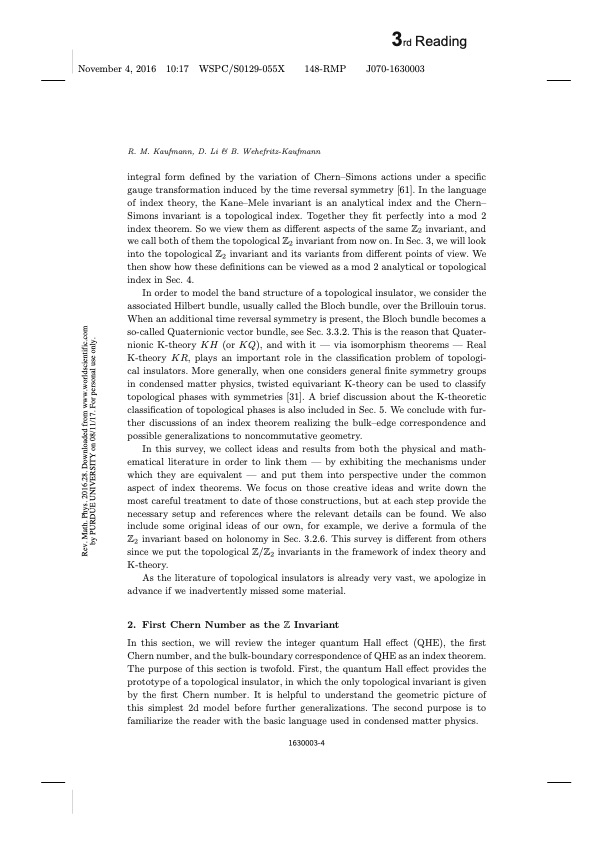
PDF Publication Title:
Text from PDF Page: 004
R. M. Kaufmann, D. Li & B. Wehefritz-Kaufmann integral form defined by the variation of Chern–Simons actions under a specific gauge transformation induced by the time reversal symmetry [61]. In the language of index theory, the Kane–Mele invariant is an analytical index and the Chern– Simons invariant is a topological index. Together they fit perfectly into a mod 2 index theorem. So we view them as different aspects of the same Z2 invariant, and we call both of them the topological Z2 invariant from now on. In Sec. 3, we will look into the topological Z2 invariant and its variants from different points of view. We then show how these definitions can be viewed as a mod 2 analytical or topological index in Sec. 4. In order to model the band structure of a topological insulator, we consider the associated Hilbert bundle, usually called the Bloch bundle, over the Brillouin torus. When an additional time reversal symmetry is present, the Bloch bundle becomes a so-called Quaternionic vector bundle, see Sec. 3.3.2. This is the reason that Quater- nionic K-theory KH (or KQ), and with it — via isomorphism theorems — Real K-theory KR, plays an important role in the classification problem of topologi- cal insulators. More generally, when one considers general finite symmetry groups in condensed matter physics, twisted equivariant K-theory can be used to classify topological phases with symmetries [31]. A brief discussion about the K-theoretic classification of topological phases is also included in Sec. 5. We conclude with fur- ther discussions of an index theorem realizing the bulk–edge correspondence and possible generalizations to noncommutative geometry. In this survey, we collect ideas and results from both the physical and math- ematical literature in order to link them — by exhibiting the mechanisms under which they are equivalent — and put them into perspective under the common aspect of index theorems. We focus on those creative ideas and write down the most careful treatment to date of those constructions, but at each step provide the necessary setup and references where the relevant details can be found. We also include some original ideas of our own, for example, we derive a formula of the Z2 invariant based on holonomy in Sec. 3.2.6. This survey is different from others since we put the topological Z/Z2 invariants in the framework of index theory and K-theory. As the literature of topological insulators is already very vast, we apologize in advance if we inadvertently missed some material. 2. First Chern Number as the Z Invariant In this section, we will review the integer quantum Hall effect (QHE), the first Chern number, and the bulk-boundary correspondence of QHE as an index theorem. The purpose of this section is twofold. First, the quantum Hall effect provides the prototype of a topological insulator, in which the only topological invariant is given by the first Chern number. It is helpful to understand the geometric picture of this simplest 2d model before further generalizations. The second purpose is to familiarize the reader with the basic language used in condensed matter physics. 1630003-4 Rev. Math. Phys. 2016.28. Downloaded from www.worldscientific.com by PURDUE UNIVERSITY on 08/11/17. For personal use only.PDF Image | Notes on topological insulators

PDF Search Title:
Notes on topological insulatorsOriginal File Name Searched:
RMP.pdfDIY PDF Search: Google It | Yahoo | Bing
Sulfur Deposition on Carbon Nanofibers using Supercritical CO2 Sulfur Deposition on Carbon Nanofibers using Supercritical CO2. Gamma sulfur also known as mother of pearl sulfur and nacreous sulfur... More Info
CO2 Organic Rankine Cycle Experimenter Platform The supercritical CO2 phase change system is both a heat pump and organic rankine cycle which can be used for those purposes and as a supercritical extractor for advanced subcritical and supercritical extraction technology. Uses include producing nanoparticles, precious metal CO2 extraction, lithium battery recycling, and other applications... More Info
| CONTACT TEL: 608-238-6001 Email: greg@infinityturbine.com | RSS | AMP |